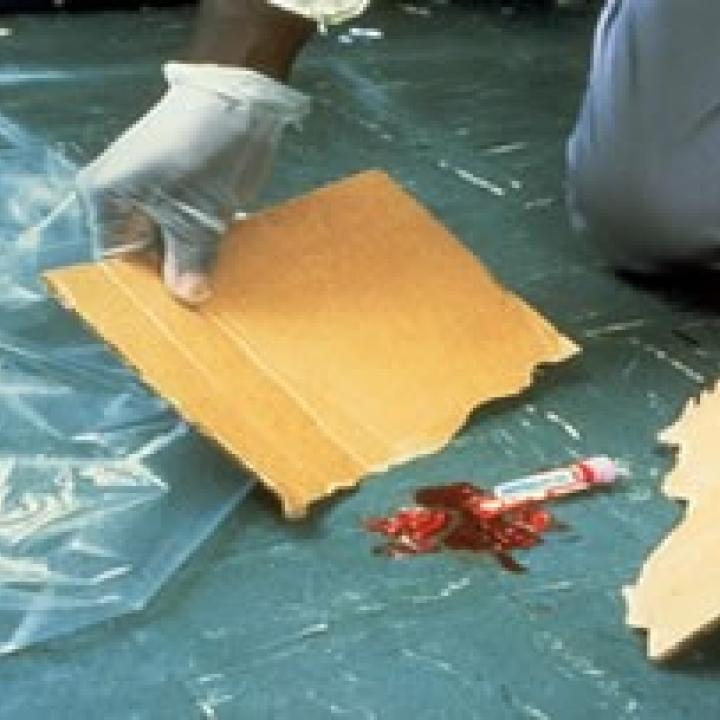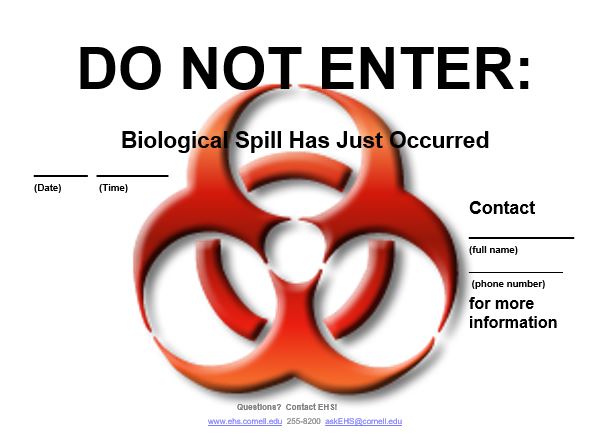Responding to Biological Spills
Guidance Document: Biological Spill Response
Immediate decontamination is essential following a biological spill. This includes spills involving cell lines, human or animal blood, bodily fluids, viral vectors, recombinant/synthetic nucleic acids (r/sNA), biological toxins, or pathogens. The consequences depend on the spill type, volume, location, and cleanup practices. Identifying potential spill sites helps determine necessary clean-up measures and decontamination supplies.
If you suspect exposure during the spill or cleanup, clean exposed areas according to the GBP for Biological Exposures and seek medical attention immediately.
1. Preparation and Planning
- Review the Biological Safety Manuals, Laboratory Safety Manual and Chemical Hygiene Plan (5.4), and Spill Cleanup Procedure for general spill response practices.
- Understand hazardous materials in the lab and identify potential spill sites.
- Ensure a spill kit and cleanup materials are available and know their storage location.
- Spill kits are available from safety supply vendors or can be assembled by lab personnel.
- Tailor spill kits to the materials specific to your lab.
Basic Spill Kit Components
For the kit, use a container like a 5-gallon plastic bucket or Rubbermaid™ tub. If no sharps container is always available in the lab, add one to the spill kit.
- 2 pairs of splash goggles
- 2 pairs of nitrile gloves
- 2 pairs of plastic, vinyl, or rubber shoe covers
- 2 disposable lab coats, aprons, or coveralls
- Absorption materials: paper towels, commercial spill pads, pillows, spill socks, and loose absorbents
Cleanup Tools and Materials
- 3-5 red biohazard waste bags for spill debris
- EHS hazardous waste labels
- Forceps or tongs for picking up broken glass or sharps
- Concentrated bleach or another appropriate disinfectant and an empty bottle for preparing a fresh 10% bleach solution. Ensure the disinfectant is not expired.
- Additional PPE: face shields, face masks, disposable lab coats, and disposable gloves
2. Key Steps Before Cleanup
- Avoid inhaling airborne material, notify others, ensure everyone leaves the room, and close the door.
- Post warning signs on all doors to the space.
- Remove contaminated clothing, turning exposed areas inward, and place them in a biohazard bag for autoclaving later.
- Allow aerosols to dissipate for at least 30 minutes before reentering the lab.
3. General Cleanup Procedure for Biological Material or r/sNA Spills
- Wash all exposed skin with soap and water.
- Report the incident immediately to your supervisor and EHS (call 911 from a campus phone or 607-255-1111 from a cell phone).
- Evaluate if you have the supplies and knowledge to clean up the spill. If not, request help from EHS.
- Assemble cleanup materials (disinfectants, absorbent material, red biohazard bags, sharps disposal container, and forceps).
- Put on protective clothing (lab coat, gloves, booties, mucous membrane protection).
- Cover the area with disinfectant-soaked absorbent material and carefully pour disinfectant around the spill. Ensure the disinfectant is appropriate for the agent and will inactivate the biohazardous material.
- Avoid spreading contamination by placing extra absorbent material around the spill perimeter and work towards the center.
- If the spill occurred inside a biosafety cabinet, keep it running, and wipe down all interior surfaces, including the grill and seams. Lift out the work surface if necessary.
- Allow the disinfectant to dwell for at least 15-20 minutes.
- Use forceps to pick up any sharp objects and discard them in a sharps disposal container.
- Use forceps or a broom and dustpan (never use your hands) to remove saturated absorbent materials and place them into a sharps disposal container. If no sharps are involved, discard materials into an autoclave bag.
- Re-apply fresh disinfectant to the spill site, air dry or wipe down with disinfectant-soaked towels after a 10-minute contact time. Place all contaminated materials into a biohazard bag.
- Soak up the remaining disinfectant and spill with fresh absorbent material and place it into a biohazard bag.
- Identify and treat surrounding areas that may have received splashes with fresh disinfectant (check furniture, freezers, etc.). Bleach solutions should not be used on metal surfaces due to corrosion risk; if used, perform a final wipe with ethanol or water to remove residues.
- Remove PPE and wash hands and exposed skin areas with soap and water.
- Report the spill event details through the University’s incident reporting system.
4. Specific Procedures
For Biological Toxins
- Develop a toxin-specific emergency procedures plan. Work with toxins of biological origin with an LD50 ≤ 100 µg/kg must be registered with the Institutional Biosafety Committee.
- Decontaminate and dispose of all waste associated with toxin work according to Federal, State, and Local laws.
- Contact EHS at 607-255-8200 for assistance with toxin spill clean-up procedures.
For Biohazardous Spills Containing Radioactive Materials
- Contact both the Radiation and Biosafety Officers (EHS: 607-255-1111) before any cleanup for assistance with procedures.
5. Important Phone Numbers
- In emergencies, dial 911 from the lab or 607-255-1111 from a cell phone. Notify other lab members and your supervisor immediately.
- For non-emergency questions, contact EHS at 607-255-8200.
6. Training and More Information
- Talk to your lab manager and/or PI to learn where spill supplies are, past spill sites, and additional safety measures.
- Contact EHS for tailored, hands-on spill response training in your lab.




